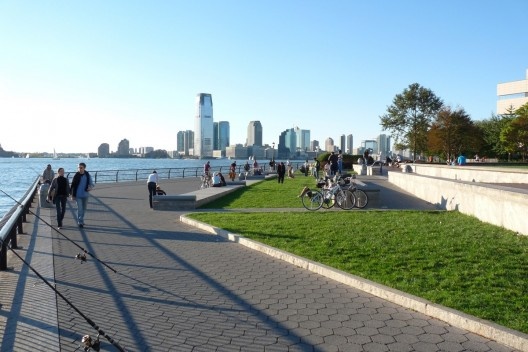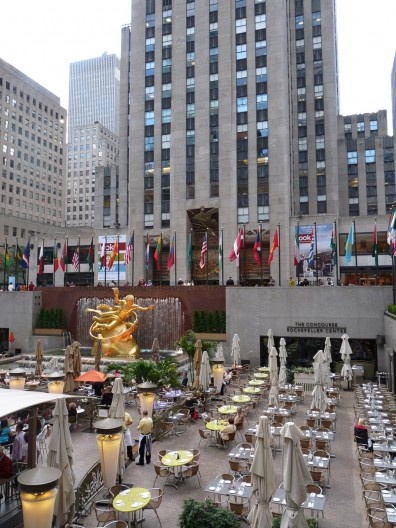
Lower Manhattan e o encontro com as águas do Rio Hudson
Foto Nicolás Sica Palermo
NS: Manhattan tem sido, desde o início do século 20, uma das capitais financeiras do mundo. E o fato de ser uma ilha foi, e continua sendo, uma condição importante para seu crescimento urbano. A arquitetura da parte sul da ilha reflete claramente estes dois aspectos. Em que partes de Manhattan o senhor acha que existem áreas passíveis de serem considerados patrimônio e deveriam ser preservadas? Que zonas - quero dizer, eixos de avenidas e ruas ou bairros - o senhor considera urbanisticamente interessantes?
KF: Eu sempre disse que Manhattan é a única cidade murada nos EUA, em virtude da água que a rodeia e define todos os seus lados. A parte sul da ilha deve, sem dúvidas, ser preservada na medida em que é a parte mais europeia. Refiro-me não só ao tecido urbano de ruas labirínticas da área de Wall Street, mas também à atmosfera mercantil do século XIX que permeia quase todos os prédios, desde o Woolworth Building, de Cass Gilbert até o edifício da Alfândega e a Bolsa de Valores. Existe também uma ligação muito íntima com a água adicionada à experiência "máquina do tempo" da balsa de Staten Island. Cada vez que bou lá, sinto que estou de volta em Liverpool. O World Trade Center de Yamasaki mudou completamente este tecido e sua desaparição violenta o alterou ainda mais.

Rockefeller Center, 1928-1938 (projeto final), 1938-1940
Foto Nicolás Sica Palermo
NS: Que oportunidades de crescimento ainda existem em Manhattan? Deveríamos falar de reformulação em vez de expansão? Que intervenções recentes parecem pertinentes e poderiam ser tomadas como referências para o futuro de outras partes da cidade?
KF: Em geral Manhattan é uma trágica história do capitalismo tardio na medida em que tem sido um "free-for-all"(concorrência ou competição sem regras) para os promotores. Embora exista a ilustre Comissão Municipal de Planejamento Urbano, não há nem uma idéia coerente de desenvolvimento da cidade sobre a mesa. É significativo o fato de que nunca houve lá um arquiteto da cidade de Nova York. Ocasionalmente, um grande edifício aparece, o edifício Seagram de Mies, o Guggenheim de Wright e, mais recentemente, os de Piano para o New York Times, mas além do Rockefeller Center - que continua a ser uma realização milagrosa - o século XX não contribuiu com nada de importância urbanística para Manhattan, e não há indícios de que o século XI vá ser melhor. É geralmente uma mistura de edifícios modernos medíocres ligados por uma trama já pronta. De fato, deveríamos reciclar o seu tecido com qualidade, sempre que possível acompanhados pelo principio de Peter Buchanan "long life-loose fit" (9).
nota
9
"The built environment accounts for about half to two-thirds of our current energy use; this alarming statistic is exacerbated by our present attitudes towards impermanence, commodification, and the rapid amortization of building stock. Buchanan goes on to show that historic buildings arc inherently more adaptable to re-use than modern structures, first because they were built to more generous standards and second because they were constructed of more durable natural material. Moreover, from the point of view of Junction they tended to be 'long life, loose fit' structures; that is to say, they may be much more readily adapted to re-use than more modem, ergonomically optimized building forms.
In relation to the potential for the adaptive re-use of pre-existing structures we should surely restrict our current habit of exploiting ex-agricultural 'greenfield' sites in favor of re-using ex-industrial brownfield sites. Rather than continuing to proliferate urban sprawl, we should either reuse obsolete buildings or demolish them and re-use their sites once they have been cleared. Only provisions of this order will save us from the continual consumption of fertile land and along with this, the ultimate depletion of the planet's non-renewable resources". Frampton, Kenneth. "On the Predicament of Architecture at the Turn of the Century", in: Hunch 6/7: 109 Provisional Attempts to Address Six Simple And Hard Questions. Rotterdam, The Netherlands: The Berlage Institute, episode publishers, and the authors. ISBN 90 805362-6-1, 2003. 516 pp.



